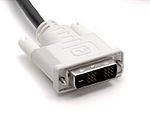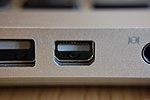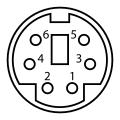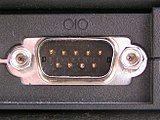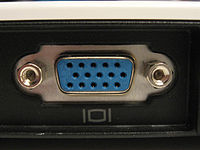Computer port (hardware)
This article has multiple issues. Please help improve it or discuss these issues on the talk page. (Learn how and when to remove these template messages)
|
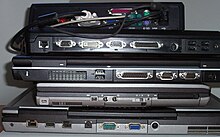

A computer port is a
Electronically, the several conductors where the port and cable contacts connect, provide a method to transfer
Bent pins are easier to replace on a cable than on a connector attached to a computer, so it was common to use female connectors for the fixed side of an interface.
Computer ports in common use cover a wide variety of shapes such as round (
Physically identical connectors may be used for widely different standards, especially on older personal computer systems, or systems not generally designed according to the current Microsoft Windows compatibility guides. For example, a 9-pin D-subminiature connector on the original
Electrical signal transfer
Electronically, hardware ports can almost always be divided into two groups based on the signal transfer:
- Analog ports
- Digital ports:
- Parallel ports send multiple bits at the same time over several sets of wires.
- Serial ports send and receive one bit at a time via a single wire pair (Ground and +/-).
After ports are connected, they typically require handshaking, where transfer type, transfer rate, and other necessary information is shared before data is sent.
Hot-swappable ports can be connected while equipment is running. Almost all ports on personal computers are hot-swappable.
Auto-detect or auto-detection ports are usually plug-and-play, but they offer another type of convenience. An auto-detect port may automatically determine what kind of device has been attached, but it also determines what purpose the port itself should have. For example, some
As of 2006, manufacturers have nearly standardized colors associated with ports on personal computers, although there are no guarantees. The following is a short list:
- Orange, purple, or grey: Keyboard PS/2
- Green: Mouse PS/2
- Blue or magenta: Parallel printer DB-25
- Amber: Serial DB-25 or DB-9
- Pastel pink: Microphone 1/8" stereo (TRS) minijack
- Pastel green: Speaker 1/8" stereo (TRS) minijack
Optical (light) fiber, microwave, and other technologies (i.e., quantum) have different kinds of connections, as metal wires are not effective for signal transfers with these technologies. Optical connections are usually a polished glass or plastic interface, possibly with an oil that lessens refraction between the two interface surfaces. Microwaves are conducted through a pipe, which can be seen on a large scale by examining
Hardware
Types of ports
Digital Visual Interface
DisplayPort
- DisplayPort
-
Mini DisplayPort
-
DisplayPort cable
-
DisplayPort
eSATA
- ESata
-
Shown on a hard-drive dock
PS/2
- PS/2 connector
Serial
- Serial port
-
DE-9
SCSI
USB
See also
- Audio and video connector
- infographic - What are PC Ports?
References
- ^ "What is a computer port?". TechTarget. 2024. Retrieved February 18, 2024.
External links
- TVicHW32, Direct Port I/O from Win32
- Interface Ports I/O form PC


